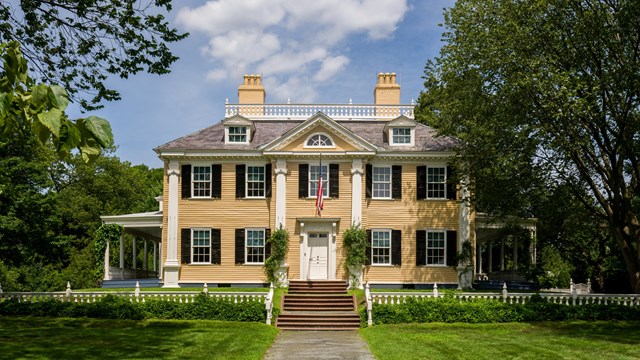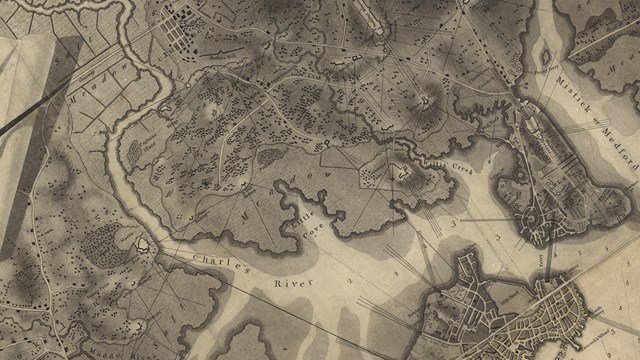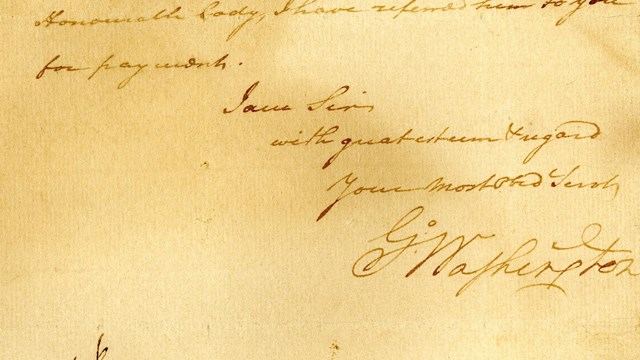Last updated: February 20, 2025
Article
Generals and Staff at Washington's Cambridge Headquarters
From July 1775 through April 1776, General George Washington used the abandoned Vassall House in Cambridge as his military headquarters during the Siege of Boston. In order to organize, administer, and command the army, Washington relied on his council of war, comprised of the senior-ranking general officers, and his "military family," comprised of the staff of secretaries and aides de camp at headquarters.
Generals
The Second Continental Congress voted on June 15, 1775, to adopt the New England army as the Continental Army, appointing George Washington as commander-in-chief. The Congress held the authority to appoint general officers in this new national institution. Between June 17 and 22 the Congress appointed general officers in this order of seniority:
- As major generals: Artemas Ward of Massachusetts, Charles Lee of Virginia, Philip Schuyler of New York, and Israel Putnam of Massachusetts.
- As brigadier generals: Seth Pomeroy of Massachusetts, Richard Montgomery of New York, David Wooster of Connecticut, William Heath of Massachusetts, Joseph Spencer of Connecticut, John Thomas of Massachusetts, John Sullivan of New Hampshire, Nathanael Greene of Rhode Island, and Horatio Gates of Virginia.
On July 22, 1775, Washington announced the reorganization of the army into six brigades, and the brigades into “three Grand Divisions” under the three major generals at the siege. The divisions were:
- Ward commanding Thomas and Spencer’s brigades “at Roxbury, and its Southern dependencies.”
- Lee commanding Sullivan and his brigade on Winter Hill and Greene and his brigade on Prospect Hill, covering the left or north side of the siege lines.
- Putnam in Cambridge commanding a brigade under Heath and a brigade “under the Command of the Senior Officer therein, and until the pleasure of the Continental Congress be known.” This division functioned as “also a Corps-de-Reserve, for the defence [sic] of the several posts, north of Roxbury, not already named.”
Generals and Officers
-
 Commander in ChiefGeneral George Washington
Commander in ChiefGeneral George WashingtonThe Continental Congress appointed George Washington to supreme command of the new army on June 15, 1775.
-
 Professional SoldierMajor General Charles Lee
Professional SoldierMajor General Charles LeeFrom July 1775, Lee commanded a division on the north side of the siege lines, including Greene and Sullivan's brigades.
-
 New England GentlemanMajor General Artemas Ward
New England GentlemanMajor General Artemas WardCommander in chief at the Battle of Bunker Hill. From July 1775, Ward commanded a division on the southern side of the siege lines.
-
 Rough-hewn HeroMajor General Israel Putnam
Rough-hewn HeroMajor General Israel PutnamFrom July 1775, Putnam commanded a division in reserve, headquartered in Cambridge in the Apthorp House.
-
 Young and EagerMajor General Nathanael Greene
Young and EagerMajor General Nathanael GreeneFrom July 1775, Greene commanded a brigade on Prospect Hill on the north side of the siege lines. He reported to Gen. Charles Lee.
-
 Boston BooksellerColonel Henry Knox
Boston BooksellerColonel Henry KnoxIn the winter of 1775-76, Washington charged Knox with the complex and crucial task of transporting artillery pieces from Fort Ticonderoga.
Military Administration
Administrative officers, secretaries, and aides de camp played essential roles in the operations and success of the fledgling Continental Army.
On June 16, 1775, the Continental Congress established the administrative positions of adjutant general, commissary general of stores and provisions, quartermaster general, and paymaster general, plus deputies. Congress deferred to Washington's recommendations on some of these positions, but once appointed, all those administrators answered to Congress, independent of the general, and most worked out of their own houses in Cambridge or elsewhere rather than as part of the headquarters staff. Nevertheless, they were part of Washington’s team.
In contrast, Washington could appoint and assign the secretary and aides de camp who lived and worked at headquarters as he saw fit. On June 21, 1775, Congress established that the commander-in-chief could employ a military secretary and three aides de camp.
A secretary needed to be trusted to draft letters, orders, and plans, especially for government officials; to set up a well-organized office; and to handle confidential information. To fill this new position, Washington selected Philadelphia lawyer Joseph Reed. After Reed departed the army to serve in the Pennsylvania provincial assembly, Robert Hanson Harrison was promoted from aide de camp to secretary in May 1775; Harrison served alongside Washington for six years of the Revolutionary War.
Military aides de camp traditionally served as messengers for their general, gathering information and delivering verbal orders. At Cambridge Headquarters, the aides de camp supported the vital stream of written communication: they composed correspondence to be signed by General Washington and copied both official and private outgoing correspondence into letterbooks.
Washington's aides came from genteel backgrounds, selected for their social status, education or profession, and good handwriting. In March 1776, Washington described his criteria for a good aide: "a plodding, methodical Person, whose sole business shd be to arrange his Papers &ca in such order as to produce any one, at any Instant it is called for, & capable at the same time of composing a Letter." Six men held the position of aide de camp during Washington's nine months in Cambridge:
- Thomas Mifflin of Pennsylvania, June to August 14, 1775
- John Trumbull of Connecticut, July 17 to August 1775
- Edmund Randolph of Virginia, August 15 to October 1775
- George Baylor of Virginia, August 15, 1775 through 1776
- William Palfrey of Boston, March 6 to 27 April 1776
- Stephen Moylan of Pennsylvania, 6 March to 5 June 1776
Administrators
-
 Quartermaster GeneralThomas Mifflin
Quartermaster GeneralThomas MifflinThe quartermaster general managed the supplies and camp facilities for the Continental Army. Appointed 14 August 1775.
-
 Adjutant GeneralGeneral Horatio Gates
Adjutant GeneralGeneral Horatio GatesThe adjutant general oversaw the communication of general orders, managed recruiting, and documented troop strengths.
-
 Surgeon GeneralBenjamin Church
Surgeon GeneralBenjamin ChurchChurch served as Surgeon General of the Continental Army from July 1775 until his exposure as a British agent in September 1775.
Secretaries and Aides de Camp
-
 SecretaryJoseph Reed
SecretaryJoseph ReedGeneral Washington's secretary from 4 July to 30 October 1775.
-
 Aide de Camp and SecretaryRobert Hanson Harrison
Aide de Camp and SecretaryRobert Hanson HarrisonAide de camp 6 November 1775 to 16 May 1776. Appointed Washington's secretary 16 May 1776.

Learn more and plan your visit to Longfellow House-Washington's Headquarters National Historic Site.

Explore the sites of fortifications, confrontations, and conflicts during the Siege of Boston on an interactive map.

For more details on the nine months Washington spent in Cambridge, see the Historic Resource Study detailing the period in 600 pages.
